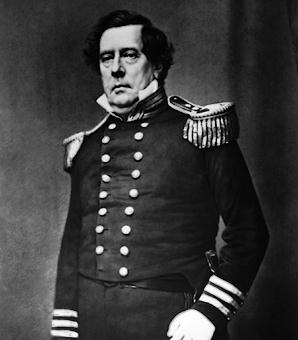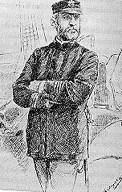
Commodore Matthew Calbraith Perry
an historical overview
published January 1, 2002
revised: February 23, 2020 (after 18 years it's about time!)

|
|
Okinawa, or "Loo-Choo" as it was known then, had been trading for centuries with neighboring countries. China, Taiwan and Korea - Singapore and the Philippines. It wasn't until the 19th century however that Okinawa was opened up to the West. Commodore Matthew C. Perry, commander of the United States naval forces in the China seas, was a staunch expansionist. Back in 1852 he warned President Fillmore that the British, who had already taken control of Hong Kong and Singapore, would soon control all trade in the area. Perry recommended that the United States take "active measures to secure a number of ports of refuge" in Japan. President Fillmore agreed with Perry. In 1853 he ordered the Commodore to open negotiations with the Emperor of Japan. At age 60, Matthew Perry had a long and distinguished naval career. He knew that the mission to Japan would be his most significant accomplishment.
American ships had long been active in the Pacific. The New England whaling fleets scoured the ocean in search of their prey. The China trade had been enriching Yankee merchants since 1784. Japan, however, had effectively closed its doors to outsiders, and it restricted foreign ships to a small part of Nagasaki. For over 200 years, no foreigner was allowed to enter Japan at all, even shipwrecked sailors were forced to remain so that no information could leak out. A strict feudal system operated, no details were available about the country. The Dutch had established trading relations with the Japanese in early 1600, but were then forced, in 1641, to remove themselves and all future trading via an artificial island called Decima. This was in the Bay of Nagasaki, it was only 600 feet by 240 feet, with a small stone bridge connecting to the mainland. A strong guard was constantly placed at the bridge to prevent foreigners entering and Japanese visiting.
As the ships sailed closer, the daimyo, his samurai, and their retainers watched in silent awe. Two huge steam frigates spouted thick black clouds as they maneuvered against the wind. With their paddle-wheels churning the water, the frigates came about, bringing their gun-decks to bear upon the shore defenses. Two sailing ships waited downwind in support. Bright signal flags fluttered from halyards.
None of the boats were permitted to come alongside any ship in the Squadron, though they all appeared quite anxious to go alongside the Flagship. Still none were permitted until we were fully convinced that a high officer was in one of the boats. Then he alone, with an interpreter who spoke Dutch, was allowed to come over the Susquehanna 's side. On board the Susquehanna, Commodore Perry's aide, Lieutenant Contee, informed the official that the Commodore carried a letter from the President of the United States to the Emperor of Japan. The Commodore intended to deliver the letter personally to an official representative. Since the Commodore was of the highest rank in the United States Navy, Contee said, he would meet only with a Japanese official of equal status. Two days later, Kayama Yezaimon visited the Susquehanna. He informed Captain Adams that the Americans must take their message to Nagasaki. Perry refused to meet with Kayama, but he wrote a message.
|
It is possible that the feudal system was beginning to collapse at this time anyway, and following the Americans visit, there were 21 years of sweeping reforms. In February, 1854, Perry returned to Edo with eight ships. He accepted the favorable reply to Fillmore's letter and visited several Japanese ports before beginning the long voyage home. His diplomatic mission had officially established the United States' presence in Asia. Still, the Americans never realized that they had been negotiating with a mere shogun. For the emperor to consult with barbarians was unthinkable. After the signing of the treaty, the Japanese invited the Americans to a feast. The Americans admired the courtesy and politeness of their hosts, and thought very highly of the rich Japanese culture. Commodore Perry broke down barriers that separated Japan from the rest of the world. Today the Japanese celebrate his expedition with annual black ship festivals.
Perry at the gates of Shuri Castle
Commodore Perry also put in at Naha, the capital city of "Loo-Choo"
(some sources spell "Lew-Chew") - the Ryukyuan island of Okinawa. |
References:
http://www.smplanet.com/imperialism/toc.html
http://www.herbaria.harvard.edu/Libraries/expinv/JAPAN.html
http://www.history.navy.mil/branches/teach/ends/opening.htm
Perry in a Nutshell
Perry, Matthew Calbraith (1794-1858), American naval officer, who commanded the expedition that established United States relations with Japan. Born on April 10, 1794, in South Kingstown, Rhode Island, the brother of Oliver Hazard Perry, he began his naval career as midshipman at the age of 15; he advanced to lieutenant in 1813 and to commander in 1826. He supervised the construction of the first naval steamship, the Fulton, and upon its completion in 1837 he took command with the rank of captain. He was promoted to commodore in 1842. In 1846-1847 he commanded the Gulf squadron during the Mexican War.
In 1853 Perry was sent on the mission to Japan, a country that had been closed to outsiders since the 17th century. On July 8, he led a squadron of four ships into Tokyo Bay and presented representatives of the emperor with the text of a proposed commercial and friendship treaty. To give the reluctant Japanese court time to consider the offer, he then sailed for China. With an even more powerful fleet, he returned to Tokyo in February 1854. The treaty, signed on March 31, 1854, provided that humane treatment be extended to sailors shipwrecked in Japanese territory, that U.S. ships be permitted to buy coal in Japan, and that the ports of Shimoda and Hakodate be opened to U.S. commerce. Perry's mission ended Japan's isolation, a prerequisite for its subsequent development into a modern nation. Perry died in New York City on March 4, 1858.
©2002-2020 Contact: ClickOkinawa.com







